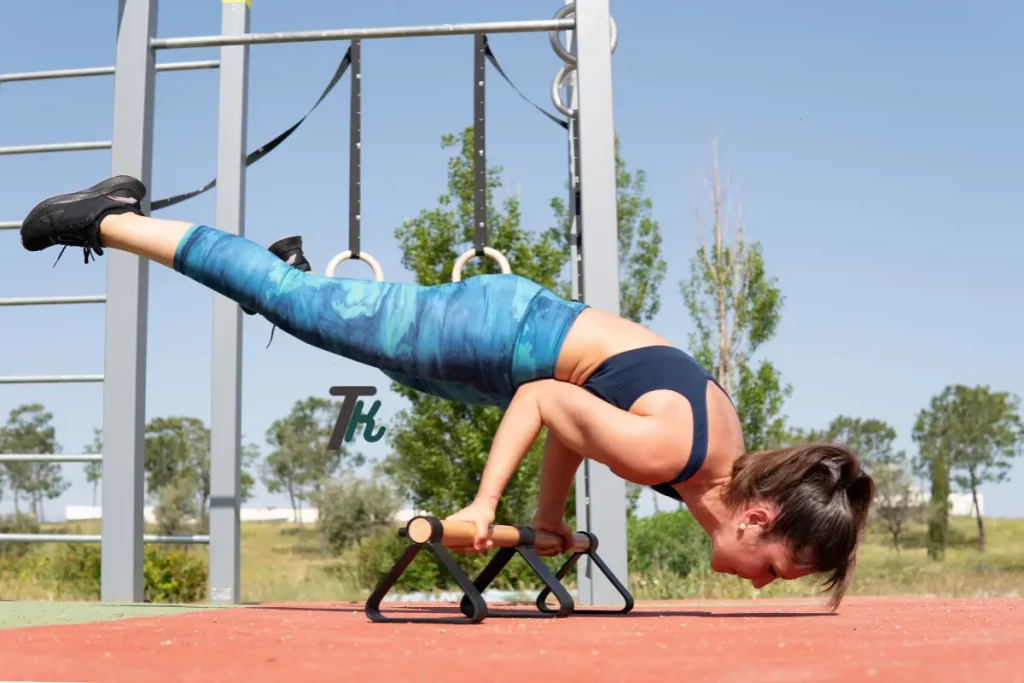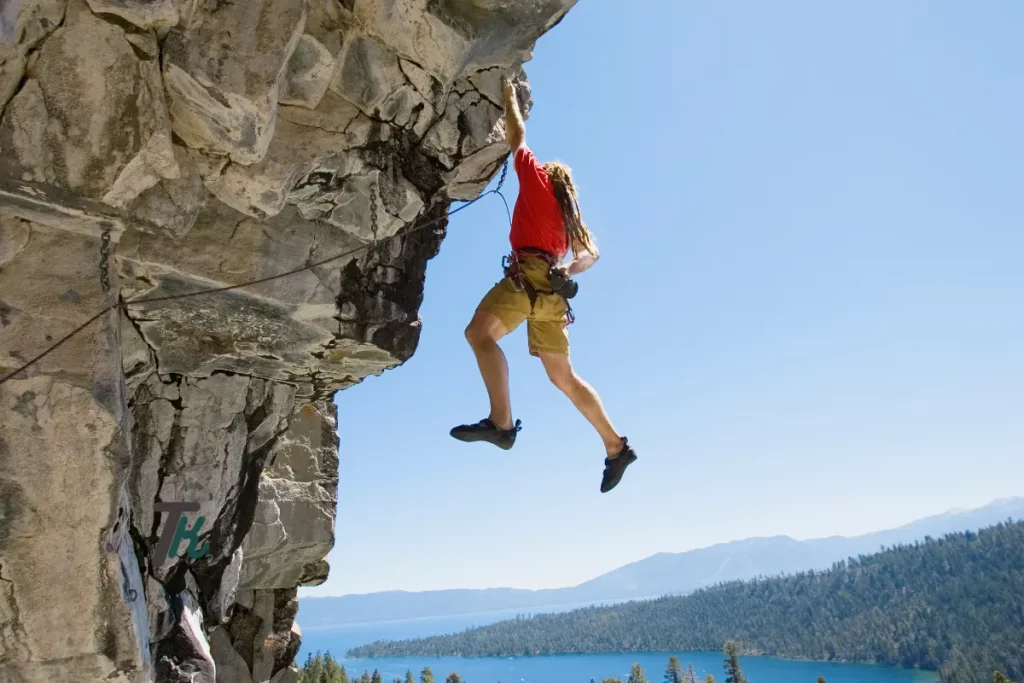As an Amazon Associate, I earn from qualifying purchases.
This article from the teamkathycarter website discusses about Is Rock Climbing Calisthenics or not.
Rock climbing is not considered calisthenics as it does not solely focus on bodyweight exercises. However, rock climbing involves using body strength and requires muscular endurance, making it a great complementary workout to calisthenics routines.
Rock climbing challenges the body to push and pull its weight against gravity, improving overall strength and flexibility. The dynamic movements of rock climbing also engage multiple muscle groups, promoting lean muscle growth and enhancing cardiovascular fitness. In addition to physical benefits, rock climbing can improve mental focus, problem-solving skills, and confidence.
The combination of physical and mental challenges in rock climbing can provide a holistic workout experience for individuals seeking to enhance their fitness levels.

The Origins Of Rock Climbing- Is Rock Climbing Calisthenics
Rock climbing, a sport that originated in the late 19th century, involves scaling natural rock formations using specialized gear and techniques. While it requires strength, balance, and coordination, rock climbing is not considered calisthenics as it involves more strategic movements and focuses on conquering challenging routes rather than repetitive exercises.
| The practice of rock climbing dates back to ancient times. | It was used for practical purposes such as hunting and gathering. |
| Rock climbing began to evolve into a recreational activity. | Modern development has seen the sport grow in popularity. |

Physical Demands Of Rock Climbing- Is Rock Climbing Calisthenics
Rock climbing is a physically demanding activity that requires both strength and endurance.
When it comes to strength, rock climbers need to have strong upper body and core muscles to pull themselves up and maintain their balance on the wall. The repetitive movements and holds in climbing also build muscular endurance.
Also, climbers need to have flexibility to reach and maneuver their bodies in different positions. This allows them to successfully navigate the climbing routes and avoid injury. Balance is another important skill in rock climbing, as climbers need to maintain their equilibrium while climbing vertically.
The combination of strength, endurance, flexibility, and balance makes rock climbing a challenging and effective form of calisthenics. Whether climbing indoors or outdoors, it provides a full-body workout that engages multiple muscle groups while also promoting mental focus and problem-solving skills.
Comparison To Calisthenics
Rock climbing and calisthenics share some similarities, particularly in terms of bodyweight exercises. Both activities require a focus on functional movements that utilize the muscles in the body to move efficiently. Calisthenics, as a form of exercise, emphasizes bodyweight exercises that engage multiple muscle groups simultaneously. Similarly, rock climbing also relies on bodyweight exercises to ascend the walls or rocks. In both disciplines, participants are challenged both mentally and physically to navigate obstacles and improve their strength and agility. So, while rock climbing may not be solely considered as calisthenics, it does incorporate elements of it by utilizing bodyweight exercises to achieve a full-body workout and improve overall fitness and strength.
Rock Climbing As A Full-body Workout- V
Rock climbing engages numerous muscles in the body, including the arms, back, and legs.
This physical activity provides cardiovascular benefits due to the continuous movement and exertion.
Skill Development In Rock Climbing- Is Rock Climbing Calisthenics
Rock climbing requires a combination of physical and mental attributes. The development of skills in rock climbing involves mastering techniques and coordination to successfully ascend routes. Focusing on mental concentration is also crucial, as it enables climbers to overcome challenges on the wall.
Incorporating Rock Climbing Into Calisthenics Training
Rock climbing is a form of calisthenics with cross-training benefits. It not only enhances overall fitness but also improves strength, flexibility, and endurance. Incorporating rock climbing into calisthenics training can provide a full-body workout that engages various muscle groups. Climbing also enhances grip strength and challenges the entire body, promoting functional strength and coordination. Additionally, it offers mental benefits such as problem-solving and focus. Rock climbing complements calisthenics by introducing a dynamic and challenging element to the training regimen, making it an exciting and effective way to achieve well-rounded fitness goals.
Injury Prevention And Safety Measures
Rock climbing involves bodyweight exercises that can be seen as calisthenics, aiding strength development. Injury prevention measures focus on proper technique and safety equipment use to minimize risks during climbing activities. Maintaining fitness and following safety guidelines are key elements in rock climbing calisthenics for a safe and effective workout routine.
| Proper Gear and Equipment | Training and Rest |
| Always wear a helmet and climbing shoes while rock climbing. | Take breaks to prevent muscle fatigue and avoid overtraining. |
| Check your harness and ropes regularly for any signs of wear and tear. | Proper warm-up exercises can help prevent injuries during climbing sessions. |
| Use chalk for a better grip and to reduce the risk of slipping. | Make sure to get enough rest between climbing sessions to allow your body to recover. |
Conclusion: Embracing The Similarities
Rock climbing and calisthenics, at first glance, may appear to be two distinct activities. However, upon closer inspection, one can appreciate the blurred lines between these two forms of exercise. Both rock climbing and calisthenics demand immense strength, balance, and coordination, making them excellent choices for personal fitness.
Rock climbing offers the thrill of conquering challenging terrains while engaging the body in a full-body workout. The focus on bodyweight movements, grip strength, and flexibility in both calisthenics and rock climbing further highlight their similarities. Whether scaling a towering wall or performing gravity-defying stunts on bars and rings, both pursuits require resilience and discipline.
Ultimately, the debate of whether rock climbing is calisthenics may be inconsequential. What truly matters is that individuals find joy, challenge, and personal growth through these activities. So whether you strap on a harness and scale rocks or embark on a bodyweight training regimen, embrace the similarities and enjoy the journey of self-discovery.
Blurring The Lines
Rock climbing and calisthenics share many similarities, including the development of strength, balance, and coordination. Both activities require discipline and resilience. While engaging in either pursuit, individuals can experience personal growth and enjoy the journey of self-discovery. When it comes to personal fitness choices, the lines between rock climbing and calisthenics become blurred as they offer similar benefits and challenges. Ultimately, what matters most is finding joy and fulfillment in an activity that speaks to one’s interests and goals. So, whether it’s clinging to a sheer rock face or mastering bodyweight exercises, embrace the similarities and find your own path to physical and mental well-being.
Frequently Asked Questions On Is Rock Climbing Calisthenics?
Is Rock Climbing Considered A Form Of Calisthenics?
Yes, rock climbing can be considered a form of calisthenics since it involves using your own body weight to climb rocks and build strength. It is a challenging full-body workout that improves muscular endurance, flexibility, and balance. Additionally, it provides the added benefits of mental focus and problem-solving skills.
How Does Rock Climbing Compare To Traditional Calisthenics Exercises?
Rock climbing offers a unique and dynamic workout experience compared to traditional calisthenics exercises. While calisthenics primarily focus on bodyweight movements and exercises, rock climbing combines strength, endurance, coordination, and balance. It engages various muscle groups in a multidimensional manner, making it a more comprehensive and challenging workout.
Are There Any Specific Calisthenics Exercises That Help With Rock Climbing?
Yes, certain calisthenics exercises can help improve your rock climbing performance. Pull-ups and chin-ups strengthen your upper body, especially the muscles used for pulling motions. Push-ups target your chest, shoulders, and triceps, providing more power for upward movements. Leg raises and planks develop core strength and stability, which are crucial for balance and control while climbing.
Last word about Is Rock Climbing Calisthenics
Rock climbing shares similarities with calisthenics, as both require strength, agility, and coordination. While calisthenics solely rely on bodyweight exercises, rock climbing incorporates other elements like mental focus and problem-solving. Whether rock climbing is considered as calisthenics is subjective, but it undoubtedly offers a great full-body workout.
As an Amazon Associate, I earn from qualifying purchases.


